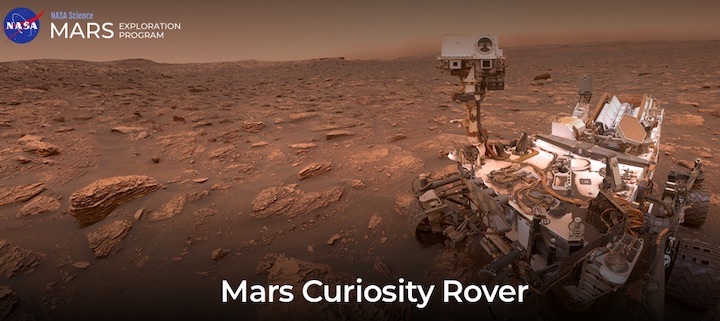26.03.2025
Fatty acid byproducts could be the remains of microbes—or not

NASA’s Curiosity rover has detected what could be a chemical relic of long-ago life on Mars: long-chain organic molecules. Found after painstaking reanalysis of data on a sample drilled from a lake that dried up billions of years ago, the molecules likely derived from fatty acids, a common building block of cell membranes on Earth. The finding, published today in the Proceedings of the National Academy of Sciences, is not a definite detection of past life; the fatty acids could also have formed without life. But it’s another in a series of tantalizing hints.
“This is an amazing result,” says Monica Grady, a planetary scientist at the Open University who wasn’t involved in the new research. If these are “breakdown products from carboxylic acids, then we are seeing something very exciting indeed.” It also suggests Curiosity’s successor, Perseverance, will find similar molecules, says Jack Mustard, a planetary scientist at Brown University. Perseverance is collecting samples for an ambitious effort to return Mars rocks to labs on Earth, where scientists will be able to reach more definitive conclusions on the molecules’ origins.
Since landing in 2012, Curiosity has traveled more than 21 kilometers in Gale crater and up the slopes of Aeolis Mons, aka Mount Sharp, the 5000-meter mountain at the crater’s center. Early on the rover showed that a lake with habitable conditions existed at Gale more than 3 billion years ago. It has since spotted other potential signs of life: goopy organic macromolecules that seem to resemble kerogen, the source material of oil, and an enrichment in a “light” carbon isotope that, on Earth, is indicative of life. “Mount Sharp keeps on giving and the rover keeps on going,” says Ashwin Vasavada, Curiosity’s project scientist at NASA’s Jet Propulsion Laboratory.
The latest result comes from a mudstone sample called Cumberland that the rover drilled in 2013, less than a year into its journey, and then analyzed in its onboard chemistry lab, the Sample Analysis on Mars (SAM) instrument. In 2015, the scientific team reported preliminary signs of long-chain organics in that sample. But that result fizzled out, as they weren’t able to identify the molecules and rule out the possibility that they might be contaminants from Earth. “It’s been a long journey to this point,” says Daniel Glavin, an astrobiologist at NASA’s Goddard Space Flight Center and co-author of the new paper. “This is really searching for a needle in a haystack.”
Curiosity analyzes rock samples by drilling them into grit, which it then decants into quartz cups inside SAM. The cups are baked at temperatures up to 1100°C, and the resulting gases are identified with a gas chromatograph-mass spectrometer. But SAM isn’t the equal of a terrestrial lab.
“The SAM data, it’s a mess,” says Caroline Freissinet, who led the new study and is now a planetary scientist at the French Laboratory for Atmospheres, Observations, and Space. To help make sense of it, researchers run experiments with a twin of the instrument, housed on Earth in martian conditions.
In 2016, a search for complex organic molecules on a saved batch of Cumberland mudstone again seemed to come up dry. But several years later, Freissinet returned to the results from the 2016 experiment. This time, with more tests from SAM’s twin to guide her, she noticed three blips that she and her colleagues had missed previously. After several months, she realized the blips pointed to three varieties of alkanes, organic molecules that string together carbon and hydrogen in a line: decane, undecane, and dodecane, which have 10, 11, and 12 carbon atoms, respectively. There wasn’t a huge amount of any of them, but they were there, in the parts per billion.
Alkanes on their own are not particularly durable, and the SAM team suspected that, prior to baking, the alkanes had carbon dioxide attached on one end, making them carboxylic acids—or fatty acids, as they’re typically called. Using SAM’s twin, they mixed a small amount of long-chain carboxylic acid into a clay-rich soil meant to mimic Cumberland, and baked it. Sure enough, alkanes were produced—just as seen on Mars—with a bloom of carbon dioxide at the same time.
Still more work was needed to rule out other sources for the alkanes. Since Curiosity landed, SAM has been plagued by solvent leaking from one of the vials it uses, in separate experiments, to extract organics from martian dirt. Yet no alkanes were produced when the team repeated the experiment on an empty cup in Curiosity, and none were found when Curiosity drilled at another site with similar characteristics, called Rock Hall. Both tests seemed to eliminate stray solvent as the source. The team also ruled out contamination from the lubricant used on the drill.
In the end they convinced themselves they had emerged from the martian haystack with a real find. “There’s no question about it,” Glavin says. “We have three needles.”
The question now is how those three alkanes got there. The enzymes that build fatty acids on Earth do so two carbon atoms at a time, meaning a predominance of even-numbered molecules indicates a living origin. Just one of the three alkanes detected by SAM, the undecane, would have come from an even-numbered fatty acid, and it is just slightly more abundant than the others. “As amazing as this is, you can’t say for sure one way or another whether these are biological products,” says Chris Herd, a geologist at the University of Alberta who wasn’t involved in the new study.
Meteorites carry cargoes of fatty acids that come not from life, but from chemical reactions in the early Solar System, and they could have easily doused the surface with fatty acids early in martian history, says Eva Scheller, a planetary scientist at the Massachusetts Institute of Technology. Or the acids could have evolved on Mars from the kerogenlike particles that Curiosity detected—which might themselves be abiotic in origin.
Although many researchers figure the origin of these molecules won’t be resolved until samples can be analyzed on Earth, Freissinet is not so sure. Cumberland was such an exciting early find that the team collected two “doggie bags” of it for later analysis. They used the first in their original research, but the second remains untouched. The SAM team is now exploring whether its onboard lab could detect a wider range of alkanes, perhaps down to a length of six carbons. If so, she says, “we might be able to find a real trend of even versus uneven carbon.”
But they only have one more shot at it. So far, no Curiosity drill site has been quite as promising as Cumberland, and the rover, whose power supply is dwindling after 13 years on Mars, has no chance of returning to it now. “This last sample,” Freissinet says, “has to be perfect.”
Quelle: Science
